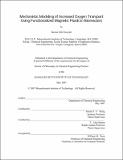| dc.contributor.advisor | Daniel I.C. Wang and T. Alan Hatton. | en_US |
| dc.contributor.author | Ollé Pocurull, Bernat | en_US |
| dc.contributor.other | Massachusetts Institute of Technology. Dept. of Chemical Engineering. | en_US |
| dc.date.accessioned | 2008-02-27T20:47:02Z | |
| dc.date.available | 2008-02-27T20:47:02Z | |
| dc.date.copyright | 2007 | en_US |
| dc.date.issued | 2007 | en_US |
| dc.identifier.uri | http://dspace.mit.edu/handle/1721.1/38966 | en_US |
| dc.identifier.uri | http://hdl.handle.net/1721.1/38966 | |
| dc.description | Thesis (Ph. D.)--Massachusetts Institute of Technology, Dept. of Chemical Engineering, 2007. | en_US |
| dc.description | This electronic version was submitted by the student author. The certified thesis is available in the Institute Archives and Special Collections. | en_US |
| dc.description | Includes bibliographical references. | en_US |
| dc.description.abstract | Absorption of gases into a liquid is of crucial importance to multiphase reactions because diffusion of a sparingly soluble gas across a gas-liquid interface generally limits the relevant reaction rates. Pertinent examples of multiphase reactions that have found application in the chemical and biochemical industries include fermentation, water treatment, and hydrogenation reactions. Gas-liquid mass transfer is of particular importance in fermentation because productivity increases in aerobic cultures are often constrained by transport of oxygen, which is only slightly soluble in water. Previous approaches to enhance oxygen transfer consisted in adding emulsified organic phases in which oxygen has a greater solubility. However, these approaches have several limitations, the most important of which is the difficult recovery of the organic phase after the fermentation. The research presented in this thesis focuses on the use of functionalized magnetic nanoparticles to enhance gas-liquid oxygen transfer. The nanoparticles have a magnetic core and an organic coating. The magnetic core makes it possible to easily recover the fluid by passing it through a magnetic field, and the coating confers colloidal stability to the particle. | en_US |
| dc.description.abstract | (cont.) Oxygen transfer enhancement has been observed in the presence of nanoparticles coated with oleic acid and a polymerizable surfactant. In cell-free media, nanoparticles improve gas-liquid oxygen mass transfer up to 6-fold (600%) in an agitated, sparged reactor. Furthermore, they show remarkable stability in high-ionic strength media over a wide pH range. In a fermentation of Escherichia coli, a nanoparticle weight fraction of 0.6% increases oxygen uptake rate and cell growth by 40%. Through a combination of experiments using both physical and chemical methods to characterize mass transfer, it has been shown that both the mass transfer coefficient (kL) and the gas-liquid interfacial area are enhanced in the presence of nanoparticles, the latter accounting for a larger fraction of the total enhancement. This insight has been used to propose a model of the enhancement that involves two separate mechanisms: one of area enhancement and the other of kL enhancement. It has been proposed that (i) the nanoparticles increase interfacial area by adsorbing on the gas bubble interface and stabilizing it against coalescence and (ii) the nanoparticles increase the mass transfer coefficient by causing microconvection in the surrounding fluid through Brownian motion. | en_US |
| dc.description.abstract | (cont.) The methodology developed in this thesis shows several-fold gas-liquid mass transfer enhancements and at the same time allows for easier separation over previous approaches. In addition, the modeling effort resulted in correlations that can allow for extension of this methodology from laboratory-scale to industrial scale reactions across the variable space considered. | en_US |
| dc.description.statementofresponsibility | by Bernat Ollé Pocurull. | en_US |
| dc.format.extent | 178 p. | en_US |
| dc.language.iso | eng | en_US |
| dc.publisher | Massachusetts Institute of Technology | en_US |
| dc.rights | M.I.T. theses are protected by copyright. They may be viewed from this source for any purpose, but reproduction or distribution in any format is prohibited without written permission. See provided URL for inquiries about permission. | en_US |
| dc.rights.uri | http://dspace.mit.edu/handle/1721.1/38966 | en_US |
| dc.rights.uri | http://dspace.mit.edu/handle/1721.1/7582 | |
| dc.subject | Chemical Engineering. | en_US |
| dc.title | Mechanistic modeling of increased oxygen transport using functionalized magnetic fluids in bioreactors | en_US |
| dc.type | Thesis | en_US |
| dc.description.degree | Ph.D. | en_US |
| dc.contributor.department | Massachusetts Institute of Technology. Department of Chemical Engineering | |
| dc.identifier.oclc | 166328413 | en_US |

